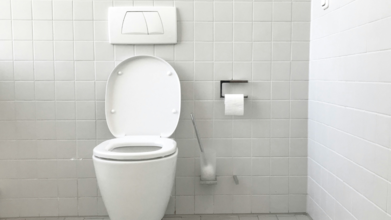- Health Conditions A-Z
- Health & Wellness
- Nutrition
- Fitness
- Health News
- Ayurveda
- Videos
- Medicine A-Z
- Parenting
No Washrooms for Women: The Shocking Health Risks of UTI, Hyperuricemia & More

Credits: Unsplash
A report by Swachh Bharat Mission says that 74.5 per cent of public places are equipped with toilets. Another report by the Ministry of Jal Shakti states that there are 2.23 lakh Community Sanitary Complexes built across all States and UTs under the Swachh Bharat Mission (SBM) since October 2014. Over 92 lakh toilets have been constructed since the launch of SBM Gramin (SBM (G)) in April 2020.
While toilets are there, are they accessible? This is the question one should ask. The National Family Health Survey (NFHS) focuses on 131 health indicators, but not until the NFHS 5 survey did they include the question of accessibility of toilets in the survey. This happened after the inputs from the Department of Drinking Water and Sanitation (DDWS) and the Ministry of Health & Family Welfare questioned the accessibility.
One might ask, why is the question of accessibility so important? The answer is quite simple. Access to water, sanitation and hygiene is the most basic human need and is also included under the Sustainable Development Goals by the UN.
Are These Numbers Real?
Just a few weeks back, I was travelling to Himachal Pradesh on a bus. While I was excited to explore the state for the first time, anxiousness gripped me. “What if I have to dehydrate myself again on the journey?” I thought.This thought crossed my mind because back in 2021, I went on a solo trip, on a bus to Udaipur from Delhi. There, the bus made two stoppages. This was done so people could get a quick dinner and freshen up, relieve themselves and be prepared for the rest of the journey. This was a nightmare. The bus only stopped for 10 minutes. While some men used the washroom, others went to the bushes.
For the women, there were three cubicles. One of them was broken, and the other one did not have a light bulb, which meant only one was usable. There was a long queue for that cubicle, and time was short. There was no point in trying to find an isolated corner, because it was past midnight, in an unknown area.
I waited anxiously. When finally, my turn came, I saw an overused, dirty washroom. The toilet seat is in a horrible condition. I wanted to touch nothing there. But I had to pee. So, I used my mask to cover my nose from the odour, folded my pants so they did not touch the floor and squatted. It was quite a task to balance.
On my way back to Delhi, I made sure to not drink any water for over a 13-hour bus journey. I dehydrated myself so I did not have to use the washroom. When I did reach, I was severely dehydrated and was sick for three days.
I shared my experience with my friends only to realise that many women have faced the same. There are no washrooms for women.
A friend of mine told me that it is because these roads and dhabas are mainly designed to serve men. They are the ones who travel at night or are on the roads most of the time. As a result, the few women who do travel or are on the road suffer.
Health Risks Women Are Prone To
Holding your pee for too long can lead to many health risks. But peeing on a dirty seat may lead to infections.Well, it is true, but partially. While holding your pee for too long can lead to health risks, peeing on a dirty toilet seat cannot lead to infections unless your urethra is in contact with the bacteria present on that toilet seat. However, nobody wants to sit on a dirty toilet seat, even if you do not get an infection. A safe and hygienic toilet is a basic need.
One of the regular saleswomen, Usha, who visits my house shared her experience with me. “Being on the road constantly means I must use the dirty public washrooms. But I do not want to use them. So, sometimes I ask my regular customers to let me use their washrooms. Some say yes, and some say no. I understand they are also concerned about their safety and privacy,” she says. As a result, Usha spends most of her day not drinking enough water and holding her pee when she is at work. Due to this, she also suffered from a Urinary Tract Infection (UTI).
Her friend, Halima too faced similar problems and due to increased levels of uric acid in her body, she suffered from Hyperuricemia.
Other health risks are kidney stones and other kidney problems, headaches, dull skin, xerostomia or dry mouth, fatigue, and urinary incontinence, which means losing control over your pelvic floor muscles leading to uncontrolled leakage of urine, seizures and weakness.
What Can You Do?
I learned my lesson from Udaipur and for this trip, I did not want to be sick. So, there are a few essentials that I carried this time with me, that you can too. Because not drinking water or holding your pee is not the solution.Wear comfortable clothes and capris. Capri pants are comfortable and are short in length, which means this won’t touch the toilet floor when you squat or sit.
Carry Essentials
I now carry a stand and pee device. With this device, you no longer must sit on the dirty toilet seat. It is a slanted funnel-like device, which can be placed between your legs when you urinate. Once you are done, you can dispose of it and throw the device in the dustbin.Even though you cannot get a UTI alone from sitting on a toilet seat, it is always safe to carry a toilet seat sanitiser. If nothing, it can help you get rid of the bad odour so you can use your stand and pee device inside the toilet. You can also use disposable toilet seat covers if your knees are weak, and you cannot squat. Always flush with your seat down.
Always keep disposable gloves, a portable bidet (fill it with water before use), a pocket liquid handwash, wet wipes, tissues and sanitiser handy. Do not forget to keep extra sanitary pads. It might sound a lot, but I promise that it all fits in one pouch. Use this travel-friendly pouch every time you are on the road, or using a public washroom.
What Can We Learn From Others?
Countries like South Korea, Japan, and China have incorporated technologies in their toilet to provide a safe experience. They have different water modes, and a button that will wipe your seat when pushed. There are buttons that change your toilet seat covers too.However, in case we do not get these technologically advanced toilets here, you can always pack a travel-friendly toilet kit!
What Is The Normal Sperm Count To Get Pregnant? Expert Explains

Credits: Canva
When talking about fertility in routine practice, we usually refer to the World Health Organization’s guideline of roughly 15 million sperm per millilitre (and around 39–40 million total per ejaculate) as the lower boundary of “normal.”
But the count alone doesn’t tell the full story. The quality of sperm, their motility, shape, and the couple’s overall reproductive health are equally important. We got in touch with Dr. Meenakshi Priya, Clinical Director & Fertility Specialist, Nova IVF Fertility, Coimbatore, who told us more about the same.
What Is The Normal Sperm Count To Get Pregnant?
Dr Meenakshi said, “Think of sperm count like lottery tickets. More tickets (higher count) give you better odds, fewer tickets lower your chances — but even one well-functioning ticket (a motile, properly shaped sperm) can win.”
That’s why fertility clinics look at several factors: concentration, total number, progressive motility (whether sperm swim forward), and morphology (shape). The WHO manual provides the standard method and cut-offs used worldwide in labs, serving as the referee for semen analysis.
However, numbers matter clinically. Research over decades shows fertility starts to drop gradually below about 40 million/ml (or in older studies, 40 million total per ejaculate was a useful marker). The WHO threshold of 15 million/ml marks the lower edge of normal — values between 15 and 40 are a “grey zone,” where conception is possible but may take longer. So a man with 12 million/ml isn’t infertile, but the couple might need help like IUI or IVF depending on other factors.
But don’t get fixated on one number. A “normal” semen report is a combination of factors:
• Concentration ≥15 million/ml
• Total sperm count ≥39–40 million per ejaculate
• Progressive motility roughly >30%
• Normal morphology about 4% (Kruger criteria)
What Changes A Sperm Count?
Lifestyle and health have a big impact on sperm. Smoking, heavy drinking, extra weight, prolonged heat exposure (saunas, hot tubs, tight underwear), certain medications, recent fevers, and conditions like varicocele or hormonal imbalances can all lower the numbers.
The good news? Most of these are reversible. Dr Meenakshi said, “Quitting smoking, reducing alcohol, losing a bit of weight, avoiding hot tubs for a few months, and treating infections can improve sperm.” Remember, sperm take time to renew but it usually takes 2–3 months of healthier habits for improvements to appear in a report. Be patient; your body is making changes even if you don’t see results immediately.
When To Be Concerned And Consult A Doctor?
If semen analysis repeatedly shows very low sperm (oligozoospermia), no sperm (azoospermia), poor motility, or if a couple has been trying for a year (or six months if the woman is over 35) without success, it’s time to consult a specialist. One abnormal test isn’t the final word — tests are usually repeated, and a more thorough assessment may include hormone checks, ultrasounds, or genetic tests if needed.
Dr Meenakshi said, “Sperm count gives a headline, not the full story. It’s a useful screening tool, but fertility decisions are personal. If you’re concerned, get a proper semen analysis and speak with a fertility specialist — many fertility issues are treatable, and acting early makes a real difference.”
Norovirus 2025: How Contagious Is the Stomach Bug Spreading Across the US

Credits: Canva
Norovirus, often called the stomach bug, has returned. Between August 1 and December 11, health officials recorded 268 norovirus outbreaks, with numbers climbing steadily as winter travel increases and more people spend time indoors. The virus triggers stomach-related symptoms such as nausea, vomiting, diarrhea, and abdominal pain or cramping.
Some people also develop fever, headaches, and body aches. Although case numbers are not rising as sharply as flu, doctors remain concerned because norovirus spreads extremely easily. Making matters worse, norovirus is difficult to kill. Many of the common precautions used against flu and COVID offer little protection against this so-called winter vomiting bug.
How Contagious Is the Norovirus?
Norovirus is among the most infectious viruses doctors deal with. “It can tear through a household and then circle back, with people repeatedly passing it to each other,” says Amy Edwards, MD, associate professor of pediatrics at Case Western Reserve University School of Medicine in Cleveland, Ohio, who specializes in infectious diseases. “It also spreads very quickly in crowded, closed settings like cruise ships.”
While contaminated surfaces can transmit norovirus, doctors say person-to-person spread is most common. An infected person can pass on the virus even before symptoms appear, throughout the illness, and after they start to feel better, Jennings warns.
What to Do If You Get Norovirus?
For most people, norovirus symptoms ease within a few days, according to Jennings. However, the illness can be more serious for those with weaker immune systems, including young children, older adults, and people with certain health conditions.
If you think you have norovirus, focus on staying well hydrated. Ongoing vomiting can quickly lead to fluid loss and electrolyte imbalance. To prevent nausea from getting worse, Jennings recommends taking small sips of clear fluids like water, ginger ale, or coconut water.
Most importantly, seek medical care right away if you become dehydrated or if diarrhea lasts for weeks. Fischer explains that dehydration may cause sunken eyes, less frequent urination, dry skin and mouth, and extreme tiredness.
Common Norovirus Symptoms That You Should Be Aware Of
Norovirus symptoms often come on suddenly and may include:
- Nausea
- Vomiting
- Stomach pain or cramps
- Watery or loose diarrhea
- General feeling of illness
- Mild fever
- Muscle aches
Symptoms usually begin 12 to 48 hours after exposure and last for one to three days. Even after recovery, people can continue shedding the virus in their stool for weeks. In some cases, especially among those with other medical conditions, shedding can continue for months. Some people infected with norovirus never develop symptoms at all. Even so, they can still spread the virus to others.
Norovirus Causes
Norovirus spreads very easily from one person to another. Because it is highly contagious, an infection can pass quickly through homes, schools, or other shared spaces. The virus is released through stool and vomit, and a person can spread it from the moment symptoms begin until several days after they feel better. Norovirus can also survive on surfaces and objects for days or even weeks.
You can catch norovirus by:
- Eating food that has been contaminated
- Drinking unsafe or contaminated water
- Touching your mouth after your hands have come into contact with a contaminated surface or object
- Having close contact with someone who is infected with norovirus
Norovirus is especially hard to get rid of because it can survive extreme hot and cold temperatures and is resistant to many common disinfectants.
Using Bisoprolol? NHS Advises Patients To Watch For These Side Effects

Credits: Canva
The NHS has issued fresh advice for people taking a widely prescribed medicine used to manage heart and circulation conditions. Across the UK, millions rely on beta-blockers to treat heart and blood vessel problems. Each year, more than 50 million prescriptions are written for these drugs, which help manage issues ranging from high blood pressure and abnormal heart rate to certain conditions affecting the brain and nervous system. Doctors most commonly prescribe bisoprolol, which NHS England lists as the seventh most prescribed medicine in the country.
What Is Bisoprolol Used For?
Bisoprolol, sold under brand names such as Zebeta, Bisotab, and Concor, belongs to a group of medicines called beta-blockers. It is mainly used to treat various heart-related conditions by slowing the heart rate and relaxing blood vessels. This reduces strain on the heart and helps it pump blood more efficiently, according to the CDC. The NHS also explains that bisoprolol is used to prevent chest pain caused by angina and to manage atrial fibrillation and other irregular heart rhythms. By slowing the heart, it allows the heart muscle to work more effectively.
Data from 2024–25 shows that bisoprolol was dispensed around 32 million times in England alone. The NHS notes that for people with high blood pressure, taking bisoprolol can help lower the risk of future heart disease, heart attacks, and strokes.
Bisoprolol Side Effects: Why Is NHS Warning Against Bisoprolol?
Like most medicines, bisoprolol can cause side effects, and patients are advised to stay alert to them. People starting the medication are often told to take their first dose at night, as it can make some feel dizzy. There are several common side effects that affect more than one in 100 people. According to the NHS, these are usually mild and tend to settle over time. They include:
- feeling dizzy or sick
- headaches
- cold hands or feet
- constipation
- diarrhoea
However, there are less common but more serious side effects that should not be ignored, as they may require urgent medical attention. The NHS advises contacting a doctor or calling 111 if:
- you experience shortness of breath with a cough that worsens during physical activity, swelling in the ankles or legs, or an irregular heartbeat, as these can point to heart problems
- the whites of your eyes or your skin turn yellow, which may be harder to notice on darker skin tones, as this can signal liver issues
Bisoprolol Warning: When Should You See Medical Emergency
The NHS also urges people to seek immediate help if certain symptoms appear. These include:
- chest pain, which could indicate heart trouble
- shortness of breath, wheezing, or tightness in the chest, which may suggest lung-related problems
Emergency services should be contacted straight away if there are signs of a severe allergic reaction, known as anaphylaxis. The NHS says to call 999 immediately if:
- your lips, mouth, throat, or tongue suddenly swell
- you are breathing very fast or struggling to breathe, with wheezing or a choking sensation
- your throat feels tight or you have difficulty swallowing
- your skin, lips, or tongue turn blue, grey, or pale, which may be more visible on the palms or soles in people with darker skin
- you suddenly feel very confused, extremely drowsy, or dizzy
- someone collapses and cannot be woken
- a child becomes limp, floppy, or unusually unresponsive, with difficulty holding their head up or focusing
The NHS stresses that while bisoprolol is effective and widely used, knowing when side effects are harmless and when they signal an emergency is key to staying safe.
© 2024 Bennett, Coleman & Company Limited

